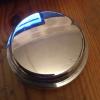Firstly, thanks to everyone for the great info! - I know I will have, and will do make mistakes - Luckily, Its just a diagram - and mistakes wont cause a fire at this stage.
Obviously there are a few components missing, however the idea of a "kill" switch to prevent the engine from starting can be acheived by inputting it into the ignition circuit, thus the engine will turn over but will not start.
Once you have the circuit diagram, you will need to produce a "power" diagram, ie power consumption for each item, this will allow you to apply circuit balancing and correct fusing strategies, also think caredfully about your fuse box MTA do some pretty good units but they are not cheap, I am using an Early S type Jaguar fuse box in my Mini, the unit is made by a company called Yazaki, don't go for the newer rounded version as it is a pain.
Best bet is to get one form a breakers and use PIDG crimps with glue lined heat shrink to seal.
But whatever you do do not solder as this very bad, as solder will wick up the wire circuits causing fatigue failures and make sure that you use the correct tools,I have seen loads of good intentions ruined by poor tooling.
What software are you using for this project ? is that Visio ?
thanks for advising on the best position for the kill switch, I know that I will have to produce a diagram for "power" in the future. I will look up those physical parts when it is necessary. I knew not to solder before I posted this.
I used some free online software for the diagram - www.circuitlab.com
I think something mentioned before as been fuses on headlights, you use 1 fuse if it blows your in complete darkness...its best if fused to have separate for each side, which means 4 fuses when you include main beam and dipped
I will use 4 fuses for the headlamps (separate dim/dip for each) and probably 2 fuses for the spot lamps (1 per pair). thanks for that.
Yes each lamp unit would be requiring a seperate fuse and also a seperate ground point, not just seperate ground wire, but multiple grounding points to stop Back EMF, voltage going "up" the "down" route.
Alongside the power chart you will also need a grounding strategy.
and if you are using a relay for individual areas you will very rapidly run out of "current" room i.e. most relais will not function very long if you pull more than 30 may be 40 Amperes max
The method used is to remove the relais and fit buss bars, most modern fuse boxes will have buss bars that are either a solid bar with terminals stamped as a single part or a "multicrimp with 3 wires (max) one side and a feed wire the other side or a crimp specially made with a number of terminals one side and a circuit feed the other.
So what circuits need separate grounds? I was probably going to ground each circuit very close to its end.
I see now that the use of relays in the diagram are inappropriate - as current draw would be constant through those while the car is being driven, so I will look up busbars as an alternative - I will most likely end up buying a modern fuse box that includes them if i implement this build.
No worries, I guess the big danger is over complicating..Can't really say there was much wrong with my 1984 loom all worked, just I shorted a main power feed a few years ago and it melted the loom..only reason I rewired mine really..
Did you rewire yours back to standard?
I added an ECU, with launch and traction control and 2 sets of spots, no radio though as the SCCR box is enough music to my ears. I then rewired the whole lot in about 1999, 2000 I applied the hierarchial logic to the wiring harness and never had any issues, if one lamp went out I still had plenty of other lighting 
I may design this to wire in a megajolt, and move away from my plain electronic ignition at the same time. I presume by hierarchial logic you mean having multiple failsafes for lights etc?
There is no point, and it will use a huge amount of fuses and extra weight of cable, to use a separate fuse for every single component. For example you are planning two completely independent circuits for your head unit. Depending on the way the unit is built one of the two feeds it needs will be using just a few milliamps and so it will be almost impossible to provide it with suitably low fusing. Given that the smallest cable you will sensibly be able to supply it from will be capable of supplying about 8 amps in open air there is no point in not putting other low risk items on the same circuit. You will not find any production car that has completely independent fusing for all equipment. Also if you are staying with Mini switchgear it's not even possible to get this level of separation. The headlamp flasher for example shares its supply with the horn inside the switch, and it is a different supply from the rest of the lighting switches. The washer pump shares its supply with the wiper motor too, again this is built into the switch.
Relaying the main circuit groups is a good idea, and features in some of my own designs, but as said you cannot use a regular relay for it. Also most high power relays are not up to the task of supplying their advertised output continuously for a long period. Technically anything supplying main power to equipment at high current and replacing the functions of a switch is called a contactor and they are built differently from relays. You will find that contactors for mains power that fit into fuse boards can carry very high currents for long periods. To do the equivalent in an automotive relay you will need to find a relay rated up around 100 amps. Essentially don't plan to use more than half it's advertised rating if you want it to last and remain reliable. It is also a very good idea to put the large, main cable you fit to the solenoid into a big mega-fuse box in the engine bay, giving the supply to each relay a large current fuse protecting all the wiring. This is also an effective way of splitting the cables up. Oh and forget the idea of using four way fuse boxes! There are lots of different boxes available out there and blade fuses are better than cartridges. The main auto electrical suppliers all carry a modular fuse and relay system that makes it very easy. It has bussing strips to join fuses together which saves a lot of hassle when it comes to actually building it.
I think you need to read up a lot more about the way the circuits in a car work first too. You have listed one fuse marked 'headlamps', at a very minimum you would need two and as said to make it safe you need four. Headlamps have two circuits, this is a very basic thing to understand in the wiring of a car. I would suggest you get yourself the Haynes Automotive Electrical Systems Techbook. It is very helpful in understanding the needs of not only the wiring and fusing but also the starting and charging systems. It lists all the wiring colour codes you need to use (they are British Standard and you should stick to them) and describes how many of the circuits actually work. Remember there are also various laws covering the way things are wired in terms of what is safe and usable in a car. The exact laws depend on the age of the vehicle but most versions of what are called the Road Vehicles Lighting Regulations and the Road Vehicles (Construction and Use) Regulations are available on line.
Wow! lots of great info Dan, thanks.
Firstly, I will probably move away from standard switch gear in the process - although maybe not the stalks, so I will have to factor in what you have said for them.
I take it you are recommending a book like this -
http://www.amazon.co...c_df_1845842154 .
Once again, thanks for all the info everybody!!!!!.



















